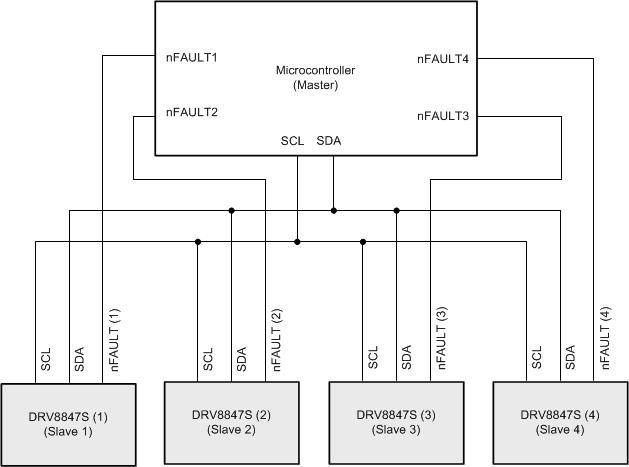SLVSE65C July 2018 – December 2023 DRV8847
PRODUCTION DATA
- 1
- 1 Features
- 2 Applications
- 3 Description
- 4 Revision History
- 5 Pin Configuration and Functions
- 6 Specifications
-
7 Detailed Description
- 7.1 Overview
- 7.2 Functional Block Diagram
- 7.3
Feature Description
- 7.3.1 PWM Motor Drivers
- 7.3.2 Bridge Operation
- 7.3.3 Bridge Control
- 7.3.4 Current Regulation
- 7.3.5 Current Recirculation and Decay Modes
- 7.3.6 Torque Scalar
- 7.3.7 Stepping Modes
- 7.3.8 Motor Driver Protection Circuits
- 7.4 Device Functional Modes
- 7.5 Programming
- 7.6
Register Map
- 7.6.1 Slave Address Register (Address = 0x00) [reset = 0x60]
- 7.6.2 IC1 Control Register (Address = 0x01) [reset = 0x00]
- 7.6.3 IC2 Control Register (Address = 0x02) [reset = 0x00]
- 7.6.4 Slew-Rate and Fault Status-1 Register (Address = 0x03) [reset = 0x40]
- 7.6.5 Fault Status-2 Register (Address = 0x04) [reset = 0x00]
-
8 Application and Implementation
- 8.1 Application Information
- 8.2
Typical Application
- 8.2.1 Stepper Motor Application
- 8.2.2 Dual BDC Motor Application
- 8.2.3 Open Load Implementation
- Power Supply Recommendations
- 9 Layout
- 10Device and Documentation Support
- 11Mechanical, Packaging, and Orderable Information
Package Options
Refer to the PDF data sheet for device specific package drawings
Mechanical Data (Package|Pins)
- PW|16
- PWP|16
- RTE|16
Thermal pad, mechanical data (Package|Pins)
- RTE|16
Orderable Information
7.5.2 Multi-Slave Operation
Multi-slave operation is used to control multiple DRV8847S devices through one I2C line as shown in Figure 7-25. The default device address of the DRV8847 device is 0x60 (7-bit address). Therefore, any DRV8847S device can be accessed using this address. The steps for multi-slave configuration for programming device-1 out of 4 connected devices (as shown in Figure 7-25) are as follows:
 Figure 7-25 Multi-Slave Operation of DRV8847S
Figure 7-25 Multi-Slave Operation of DRV8847S- The DRV8847S device variant is configured for multi-slave operation by writing the DISFLT bit (IC2_CON register) of all connected devices to 1b. This step will disable the nFAULT output pin of all DRV8847S, to avoid any race condition between master and slave I2C device.
- Pull the nFAULT pins (nFAULT2, nFAULT3, and nFAULT4 pins) of three devices (2, 3, and 4) to low to release the I2C buses of the slave device (device-2, device-3 and device-4). Now only device-1 is connected to master.
- Since, only one device, DRV8847S (1), is connected to the controller, and, therefore, its slave address can be reprogrammed from default 0x60 (7-bit address) to another unique address.
- Similarly, the slave address (SLAVE_ADDR) of the other three devices (device-2, device-3 and device-4) can be reprogrammed sequentially to unique addresses by a combination of nFAULT pins.
- When all slave addresses are reprogrammed, write the DISFLT bit to 0b (IC2_CON register). This will enable the nFAULT output pin for fault flagging.
- All the nFAULT pins are released and a multi-slave setup is complete. Now all connected slave devices can be accessed using the newly reprogrammed address.
- The above steps should be repeated for any device in case of a power reset (nSLEEP). .